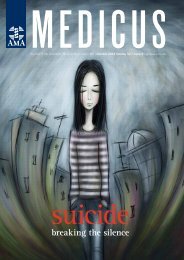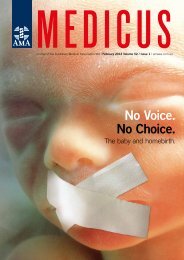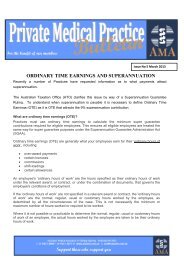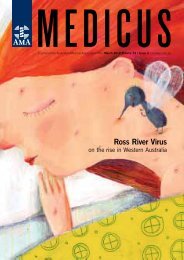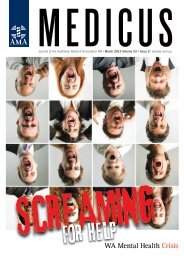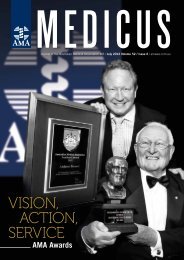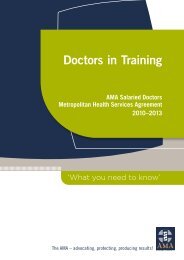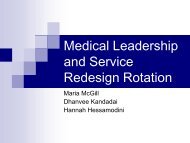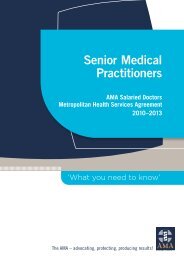twrama 1841_august_2.. - AMA WA
twrama 1841_august_2.. - AMA WA
twrama 1841_august_2.. - AMA WA
Create successful ePaper yourself
Turn your PDF publications into a flip-book with our unique Google optimized e-Paper software.
Desperately seeking<br />
FEATURE<br />
by Pauline Costins<br />
Eligible midwife<br />
collaboration<br />
Collaboration’ is not a dirty word. Far from it. The<br />
National Health and Medical Research Council<br />
(NHMRC) defines collaboration as “a dynamic process<br />
of facilitating communication, trust pathways that enable<br />
health professionals to provide safe, woman-centred care.<br />
Collaborative maternity care enables women to be active<br />
participants in their care. Collaboration includes clearly<br />
defined roles and responsibilities for everyone involved in<br />
the woman’s care, especially for the person the woman sees<br />
as her maternity care provider”.1<br />
An eligible midwife is able to provide comprehensive<br />
midwifery care for women who choose this model of care.<br />
Of course, an eligible midwife:<br />
• must have insurance<br />
• must have a Medicare provider number<br />
• requires collaborative arrangements<br />
• women can claim a rebate for services<br />
• can provide diagnostic tests; and<br />
• can prescribe once endorsed (course current at Flinders<br />
University).<br />
An eligible midwife requires collaboration in order for the<br />
midwife to claim the Medicare rebate utilising her provider<br />
number. This process was set out in the National Health<br />
(Collaborative Arrangements for Midwives) Determination<br />
2010.<br />
The collaboration can be in several formats – a formal<br />
collaborative agreement, a referral letter, or the midwife<br />
needs to clearly document the process of collaboration with<br />
acknowledgement from the collaborating doctor (this last<br />
point is difficult and arduous).<br />
The course for pharmacology has been endorsed and<br />
commenced at Flinders University. Once this is completed, the<br />
eligible midwife becomes an endorsed midwife and is able to<br />
prescribe from an approved formulary.<br />
A continuity of the Midwifery Care Model can be offered<br />
to all women regardless of the risk category. If at the booking<br />
visit (eight to 10 weeks), a risk factor is identified (as per<br />
ACM consultation and referral guidelines) the woman will<br />
be referred to an obstetrician or GP obstetrician as soon as<br />
possible for assessment and further advice. Some private<br />
practice midwives would like to continue to provide midwifery<br />
care for this woman together with obstetric care.<br />
If the woman is low risk, then she will be booked in for a<br />
hospital visit at 19–20 weeks where she will have her booking<br />
appointment and if all is well, will continue to see the<br />
midwife until 36/40 weeks where another hospital visit will be<br />
scheduled.<br />
Most women want a hospital birth (99 per cent) with<br />
continuity of midwifery care. They want antenatal care in<br />
the home and support at home for early labour. The woman<br />
will labour at home until an established labour and will then<br />
proceed to hospital for a planned hospital birth. The midwife<br />
will care for the woman within the hospital setting and then<br />
if all goes well, will transfer her home four to six hours post<br />
birth. Furthermore the new mother will be provided with six<br />
weeks postnatal care at home if she requires or requests this.<br />
If the woman is low risk and requests a homebirth, this too<br />
will be facilitated.<br />
Eligible midwives work in a variety of settings and several<br />
have some form of collaborative agreement with a GP<br />
obstetrician. However, this does not yet include intrapartum<br />
care. Current collaborative agreements in <strong>WA</strong> do not cover<br />
intrapartum care. The state is not unique; with this issue<br />
presently, there are about three collaborative agreements<br />
throughout Australia that include all facets of care of which<br />
Dr Andew Pesce is engaged in one. Presently in <strong>WA</strong>, only<br />
two hospitals facilitate continuity of care for these women by<br />
employing the midwives on a casual basis for the birth.<br />
<strong>WA</strong> Health is developing a framework that includes<br />
credentialing and access agreements but progress is slow. In<br />
all other hospitals, the midwife accompanies the woman as a<br />
support person – the women find this option unacceptable as<br />
they have employed a midwife, not a doula.<br />
Benefits for the women include true choice and better<br />
outcomes. For the system, women are being diverted from<br />
overcrowded hospital waiting rooms – early labour at home<br />
prevents blocking labour ward beds.<br />
There is countless evidence to suggest that women who have<br />
continuity in labour have better outcomes. The woman will<br />
bring a midwife to the labour room, again relieving pressure<br />
on a busy labour ward...then a six-hour discharge and followup<br />
care for six weeks if they so choose. GP obstetricians/<br />
obstetricians can refer women to eligible midwives for<br />
postnatal care, therefore discharging women earlier from<br />
hospital.<br />
Some benefits for doctors are that they can refer women to<br />
an eligible midwife for shared antenatal and postnatal care to<br />
free up busy surgeries. This can be easily achieved by referring<br />
women to eligible midwives and this is a type of collaborative<br />
arrangement<strong>2.</strong> This would then enable the woman/midwife to<br />
claim Medicare using her provider number.<br />
The legal responsibilities are the same for any health<br />
professional; you work within your scope of practice and<br />
ensure correct referrals are in place. Shared care utilising<br />
Continued on page 24<br />
August MEDICUS 23




